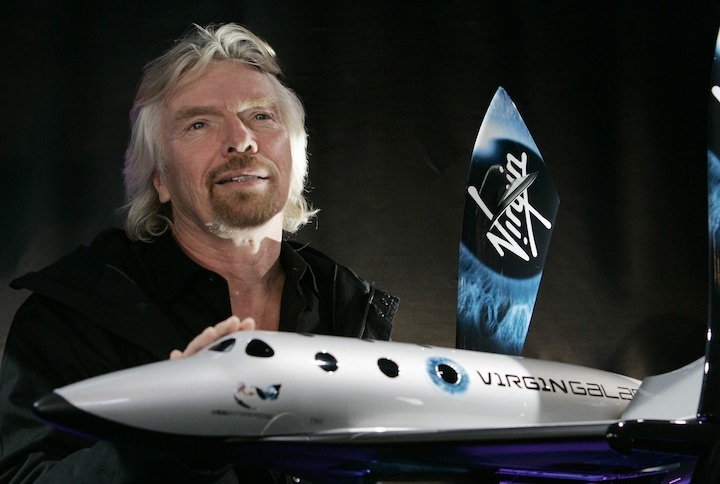
12.01.2018
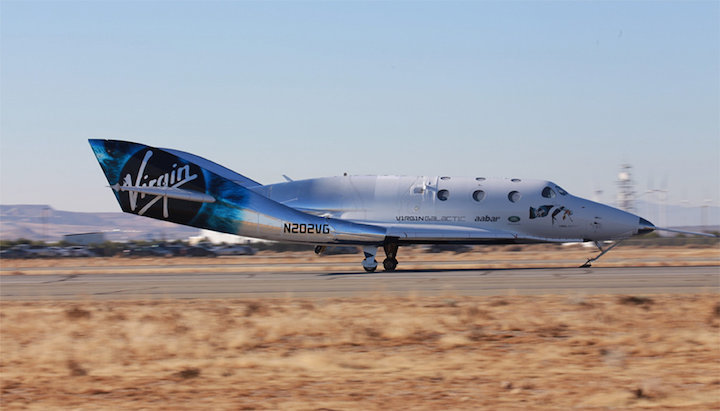
Virgin Galactic's VSS Unity vehicle on the ground in Mojave, California, after a successful "glide flight" on Jan. 11, 2018.
-
Virgin Galactic's second SpaceShipTwo vehicle has taken to the skies once again.
The spacecraft, known as VSS Unity, completed its seventh unpowered "glide flight" today (Jan. 11) over Mojave, California, Virgin Galactic representatives said.
Unity hadn't been aloft since August 2017. Engineers and technicians had spent the intervening five months making sure the vehicle will be ready for the higher loads of rocket-powered flight when the time comes, according to the company.
"Today we tested that work by pushing Unity’s atmospheric capabilities hard, touching top-end glide speeds as pilots Mark 'Forger' Stucky and Michael 'Sooch' Masucci completed a busy test card," Virgin Galactic wrote in an update today.
"After release from mothership VMS Eve, the spaceship was immediately pushed into a sharp descent, accelerating to Mach 0.9, which is around the maximum airspeed we can achieve without igniting the rocket motor!" they added. (Mach 1 is the speed of sound — 767 mph, or 1,234 km/h, at room temperature.)
As that note indicates, SpaceShipTwo is designed to be carried aloft by a specialized airplane. During operational flights, the spacecraft will be dropped at an altitude of about 50,000 feet (15,000 meters), then boost itself to suborbital space using its own rocket motor.
The passengers aboard — SpaceShipTwo can fit six paying customers, along with two pilots — will get to experience a few minutes of weightlessness and see the curvature of Earth against the blackness of space before gliding back down to Earth.
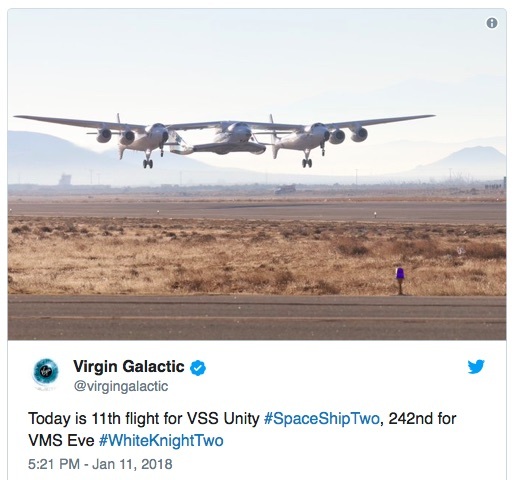
Tickets to ride SpaceShipTwo currently sell for $250,000. To date, more than 600 people have put a deposit down for a seat, Virgin Galactic representatives have said.
But VSS Unity will have to ace some powered flights before it can start taking customers and research payloads to suborbital space. The company is laying the groundwork for powered tests: During today's flight, Unity carried water ballast to simulate the rocket motor's weight, and it was outfitted with a thermal protection system, which will shield the spacecraft from the heat and friction of atmospheric re-entry, Virgin Galactic representatives said.
Unity is Virgin's second SpaceShipTwo vehicle. The first, VSS Enterprise, broke apart during a rocket-powered test in October 2014. The tragic accident killed co-pilot Michael Alsbury and injured pilot Peter Siebold.
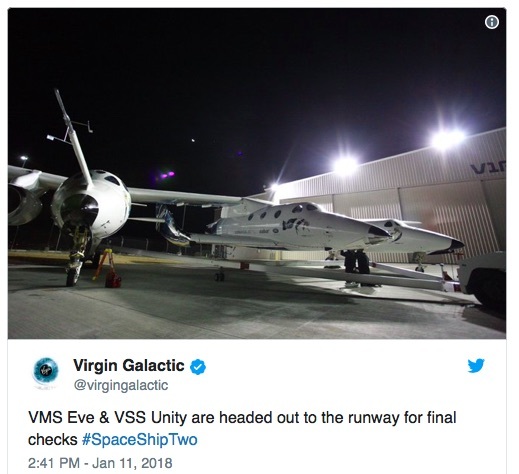
Quelle: SC
+++
Update From Mojave: VSS Unity Successfully Completes High Speed Glide Flight
January blues? Not a problem in Mojave today as VSS Unity successfully completed her seventh glide flight!
It’s been a few months since our last flight, during which we worked through a planned period of focused ground time. This involved extensive analysis, testing and small modifications to ensure vehicle readiness for the higher loads and forces of powered test flight. Today we tested that work by pushing Unity’s atmospheric capabilities hard, touching top-end glide speeds as pilots Mark ‘Forger’ Stucky and Michael ‘Sooch’ Masucci completed a busy test card.
Alongside confirming the work that has taken place on the ground, the glide flight tested transonic flight performance, stability and control. After release from mothership VMS Eve, the spaceship was immediately pushed into a sharp descent, accelerating to Mach 0.9 which is around the maximum airspeed we can achieve without igniting the rocket motor!
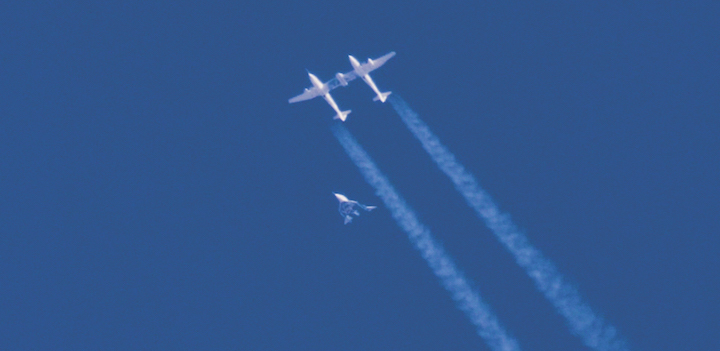
At this stage of the glide flight programme, each flight is essentially a dry run for rocket-powered test flights. Where possible the team replicates those powered flight conditions by, for example, adding water ballast to simulate the weight and positioning of the rocket motor. As during previous flights, the water ballast was jettisoned at around 22,000 feet, allowing the pilots to complete the flight and land in a lighter configuration, again simulating the conditions which will apply during space flight. Also as a precursor to powered flight, VSS Unity flew today with her thermal protection system (TPS) fully applied. This ensures that heat loads generated by air friction during rocket-powered boost and supersonic re-entry cause no damage to the vehicle. It’s a good look though, with the upper surfaces of the previously white feather flaps now covered in a protective silvered film.
Congratulations to Forger and Sooch, as well as VMS Eve crew, CJ Sturckow, Kelly Latimer and Richard Starke, for a well-executed flight, supported of course by the Virgin Galactic and The Spaceship Company teams on the ground.
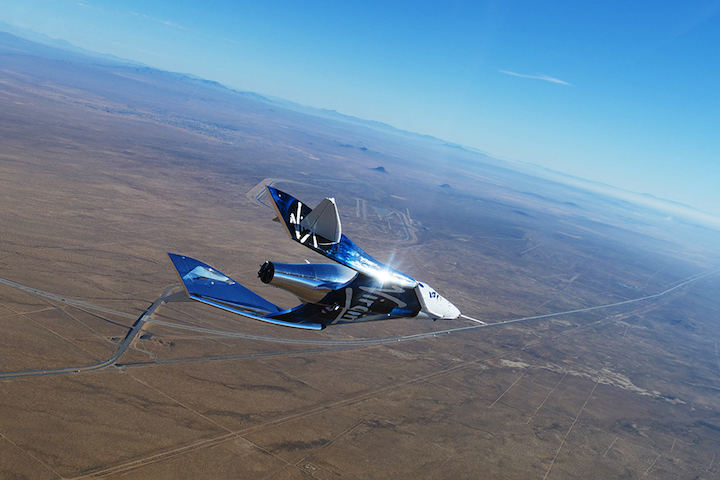
Quelle: Virgin Galactic
----
Update: 19.01.2018
.
Infinity and beyond: Will Virgin Galactic ever make it into space?
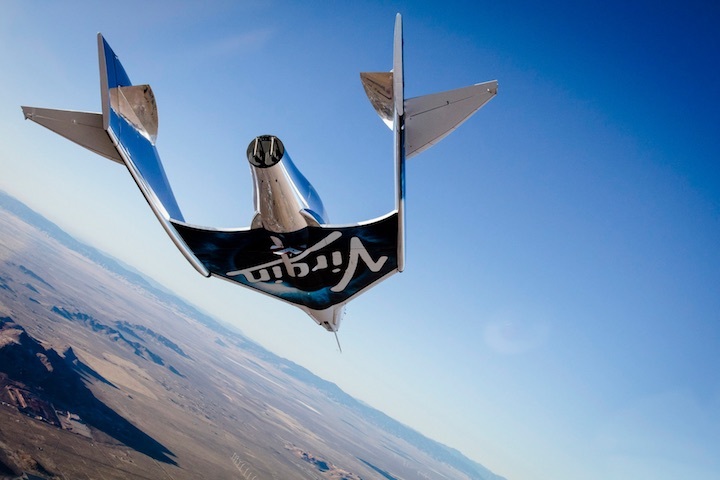
Look up to the skies in the next few months, and you might see something which approximates a shooting star zipping across the firmament.
At least, that's the theory.
This week has seen a new development in what might be deemed the 21st century version of Waiting For Godot - specifically, an update from Virgin Galactic about its much-promised but little-delivered plans to offer space flights for paying tourists.
Last Thursday saw the company's state-of-the-art craft VSS Unity complete another test flight. It was released from its WhiteKnightTwo "mothership" above the Mojave Desert in California, and put through a series of rigorous procedures.
These included a sharp descent from the launch height of 50,000ft, and an acceleration to Mach 0.9 to test its capabilities and stability - before a safe landing.
The successful flight has been greeted with a shower of tickertape.

"January blues? Not a problem in Mojave today as VSS Unity successfully completed her seventh glide flight!" began a Virgin Galactic press release issued just after the craft had touched down.
"At this stage of the glide flight programme, each flight is essentially a dry run for rocket-powered test flights," it continued.
"As during previous flights, the water ballast was jettisoned at around 22,000 feet, allowing the pilots to complete the flight and land in a lighter configuration, again simulating the conditions which will apply during space flight.
"Also as a precursor to powered flight, VSS Unity flew today with her thermal protection system (TPS) fully applied. This ensures that heat loads generated by air friction during rocket-powered boost and supersonic re-entry cause no damage to the vehicle.
"It’s a good look though, with the upper surfaces of the previously white feather flaps now covered in a protective silvered film."
It all sounds very positive, and seems to support Richard Branson's recent assertion that Virgin Galactic could be in space - with him on board - in the very imminent future.
"We are hopefully about three months before we are in space, maybe six months before I’m in space,” Virgin Galactic's founder told an audience during a question-and-answer session at the Nordic Business Forum in Helsinki in October.
But will this be the case? Over the last decade, Virgin Galactic has become as famous for its setbacks as its grand ambitions. Here, we look back at some of its false starts.
2004
Virgin Galactic is set up by Sir Richard Branson. A year later, it forms a partnership with the Spaceship Company, which will build the high-speed craft that, it hopes, will take its clients into high-altitude weightlessness. The Spaceship Company sets about manufacturing SpaceShipTwo, a sub-orbital spaceplane designed with this purpose in mind.
July 2008
WhiteKnightTwo, the cargo aircraft that will be used to convey the SpaceShipTwo spacecraft to release altitude, is unveiled at Mojave Spaceport in California. Branson says that Virgin Galactic's maiden space flight will take place within a year and a half.
"We are naming it Eve after my mother, Eve Branson," he says of WhiteKnightTwo. He adds that it will also bear this name "because it represents a first and a new beginning, the chance for our ever-growing group of future astronauts and other scientists to see our world in a completely new light."
Feeling confident, he adds: "Let's go 20 years forward, if all of this goes to plan, I hope that we will have a hotel in space; and in that hotel I hope we will have small spaceships that can go around the Moon - an excursion."
December 2009
The first SpaceShipTwo, named - with a nod and a wink to Star Trek - VSS Enterprise, is given its public debut at Mojave Spaceport. Another likely launch date 18 months into the future is mooted. "This is a truly momentous day. The team has created not only a world first but also a work of art," Branson says. "When I saw it I was as near being reduced to tears as is possible without actually crying."
March 2010
Eve and VSS Enterprise partner up for their first joint flight. The pair depart from Mojave Spaceport on March 22. “Watching VSS Enterprise fly for the first time really brings home what beautiful, ground-breaking vehicles Burt [Rutan, of the Spaceship Company] and his team have developed for us,” Branson says.
April 2011
By now, more than 300 people have booked space flights at $200,000 (£145,000) a head, but Branson announces further delays. "I hope 18 months from now, we’ll be sitting in our spaceship and heading off into space," he says.
February 2012
Eve and VSS Enterprise complete their 15th joint test, but are still some way short of the necessary velocity. One of these supersonic flights achieves a speed of 1,100mph for 20 seconds, but is still a long way off the 2,500mph for 70 seconds needed to carry its full capacity of six passengers into space.
May 2013
Branson tells a radio show in Dubai that a Virgin Galactic space flight is, once again, on the cusp of happening. What's more, he names the date. It will be on Christmas Day 2013, and he will be on board. "Maybe I’ll dress up as Father Christmas," he declares.
December 25 2013
There are no reported sightings of an orbiting billionaire in a white beard and red suit.
January 10 2014
VSS Enterprise manages its third rocket-powered test flight - a success which also sees the first outing for a thermal protection coating on the craft's tail.
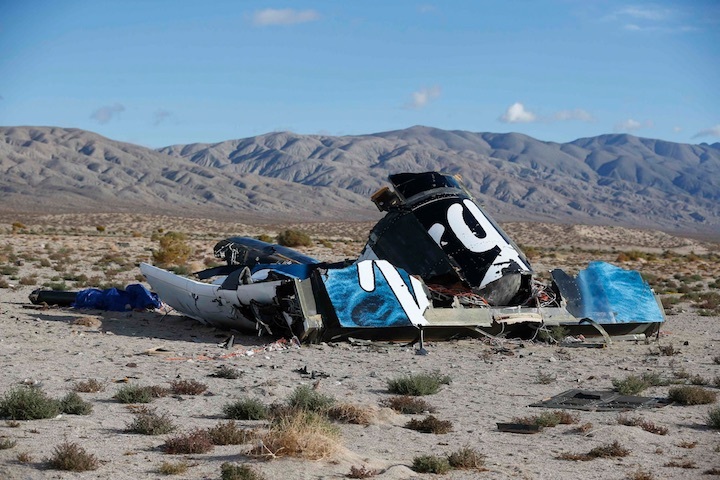
July 2014
Having given her name to the first WhiteKnightTwo, Eve Branson goes on record. Speaking to the Observer as she turns 90, she says that she intends to go into space on one of her son's craft. “I think it’s the end of the year," she replies, when asked when this will be - before adding: “It’s always ‘the end of the year’.”
September 2014
Branson Jnr is back at the predictions game. In a televised interview on talk-show host David Letterman's nightly programme, he pins his hat to the first space flights taking off in "February or March next year". The Sunday Times subsequently reports the growing disgruntlement among customers who have already paid for their flights, under the headline "The $80m Virginauts stranded on Earth".
October 9 2014
George Whitesides, the chief executive of Virgin Galactic, makes an honest admission. "We’ve changed dramatically as a company," he tells the Guardian. "When I joined in 2010, we were mostly a marketing organisation. Right now we can design, build, test and fly a rocket motor all by ourselves and all in Mojave, which I don’t think is done anywhere else on the planet”
He praises the clients who have already coughed up for a space flight. "We have a terrific customer,” he says. “It is easy to be critical of hard big things from the sidelines, but these are folk who have put their money where their mouth is. They want to achieve their dream and they view us as having the best chance of doing that.”
October 31 2014
VSS Enterprise crashes during a flight over the Mojave Desert, killing one of its two pilots. The test begins smoothly, with the craft disengaging properly from its WhiteKnightTwo carrier at 50,000ft. However, some 90 seconds into the flight, an "anomaly" sees it break apart. Pieter Siebold parachutes to safety, but his co-pilot Michael Alsbury does not survive.
The accident is an obvious setback in Virgin Galactic's bid to receive a licence from America's Federal Aviation Administration (FAA) to carry passengers on a commercial basis.
February 2016
VSS Unity, a replacement for VSS Enterprise, makes its first public appearance (on February 19).
December 2016
VSS Unity completes its first "glide" test flight (where it detaches from its WhiteKnightTwo carrier). It manages this for ten minutes.
October 2017
Branson tells a business conference in Finland that it will be "about three months before we are in space, maybe six months before I’m in space."
January 2018
Another positive test flight sees renewed Virgin Galactic talk of a launch this year.
Quelle: The Telegraph

